
The summer of 1566 saw the last attempt of the Turkish sultan Suleiman the so-called "magnificent", to neutralize the Habsburgs, also occupying Vienna. On May 1, 1566 Suleiman, at the head of a huge army that according to some sources numbered 300,000 men. Other sources state 100-200,000 men.
On July 27, 1566 the huge Turkish army arrived in Belgrade. There he was informed by his ally Zapolia that an Austrian force had attacked and destroyed a Turkish camp at Ziklos. After this, Suleiman changed his plans and decided to move towards Sigetvar where the person responsible for the Turkish defeat at Ziklos had taken refuge.
This was none other than the Croatian Habsburg general Nikola Zrinski, an experienced and brave warrior, a veteran of the wars against the Turks since the siege of Vienna in 1529, when he was only 19 years old. Now at 58 he was ready for anything, without fear. Zrinsky with only 2,300 men would defend Sighetvar against Suleiman's hordes, the vanguard of which arrived before the small fortified town on 2 August. However, the defenders showed from the beginning how the conflict will develop.
With continuous sorties they killed hundreds of Turks, before the main body arrived and blocked them. Suleiman and his army arrived before the city on August 5. The Turkish dynast set up his luxurious tent on an adjacent hill. However, Suleiman was old and sick. So he assigned the direction of the battle to his grand vizier Sokolu Mehmet Pasha, maintaining high supervision.
The few soldiers of Zrinski, mostly Croats, but also Hungarians, were confined behind the walls and awaited the enemy. The city was divided into three separate parts, the old city, the new city and its castle.
Each part was separated from the other by a wide moat while the city was only accessible from one side due to the marshes. In order to take control definitively, the new city had to fall first, then the old city and finally the castle.
Zrinsky welcomed Suleiman solemnly, raising all the flags and hanging red cloths from the walls, hinting at the Turkish blood to be shed. This enraged the Turkish sultan who, the next day, ordered the first major assault against Sighetvar, without even waiting for his artillery to achieve a breakthrough. But the defenders fought furiously and thousands of Turkish corpses witnessed their failure. New attacks followed and fierce resistance by the defenders who knew they were alone, as Emperor Maximilian II could not send reinforcements.
Suleiman then asked Zrinsky to surrender the city, offering him favorable terms. The haughty general did not even answer. After this, with a new assault, the Turks succeeded in taking possession of the new city. The defenders retreated to the old town and castle. In this way a month passed with the Turks suffering terrible losses. And the defenders were weakening. Meanwhile, on September 6 Suleiman died in his tent of natural causes. His generals kept his death a secret from their soldiers.
Until death
On September 7 the Turks prepared for a new general attack. On the other side the losses, the sabotages and the terrible cannonade had left their traces. The garrison had been decimated and the walls had collapsed in many places. The Turkish cannons thundered furiously before the 7th of September was well and truly etched. Soon the whole castle was "burning". The Turks roared wildly into the old city. Zrinsky understood that their last hour had come.
“Let us emerge from the burning ruins and fight our enemies. Whoever dies will find himself close to God. Whoever lives, will live honored. I'll go first and whatever I do you do too. God is my witness, I will never abandon you, my brothers and my knights," Zrinsky told his men before the final, death-defying exodus he prepared with the aim of becoming a holocaust.
At the time when the Turks, having conquered the old city, were moving towards the castle, through the narrow bridge that connected it with it. Suddenly the gate of the castle opened and a howitzer filled with pieces of chain and balls of arquebuses and muskets appeared. A terrible noise was heard and hundreds of Turks fell... It is estimated that at least 600 Turks were killed by this single shot, as they charged in a pack...
The last 600 or so defenders soon after rushed out with Zrinsky at their head. But the brave general was killed almost immediately by receiving two musket balls in the chest and an arrow in the head. His men, pressed by the Turkish mass, retreated step by step towards the castle except for seven men who fought and managed to escape and save themselves. They were also the only survivors. The Turks entered the castle but there they were faced with Zrinsky's last surprise.
The general had placed 3,000 pounds of gunpowder in the castle and had given orders that as soon as the Turks entered the undermining would be blown up. According to tradition, the general had charged a girl with the macabre mission. It is not certain who lit the fuse. The issue is how it ignited and the gunpowder exploded, killing around 3,000 Turks.
The losses of the Turks were appalling. During the siege, 35,000 men were lost, including 7,000 janissaries. Few of the Christians were saved. The Turks cut off Zrinsky's head and sent it to the new Sultan Selim. The body of their brave adversary, however, was buried with honors by a Turkish prisoner whom the general had saved from death. After that the Turks retreated. They had lost valuable time and many men in continuing on to Vienna. It is worth noting that Suleiman's death was kept secret for three more weeks, while the sultan's personal physician was also murdered in order not to reveal the secret.

The three sections of the City.

Zrinsky.

PANTELIS D. KARYKAS
